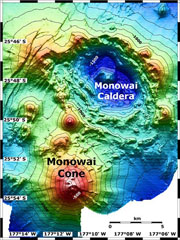Report on Monowai (New Zealand) — December 1995
Bulletin of the Global Volcanism Network, vol. 20, no. 11 (December 1995)
Managing Editor: Richard Wunderman.
Monowai (New Zealand) Earthquake swarm in late November detected acoustically
Please cite this report as:
Global Volcanism Program, 1995. Report on Monowai (New Zealand) (Wunderman, R., ed.). Bulletin of the Global Volcanism Network, 20:11. Smithsonian Institution. https://doi.org/10.5479/si.GVP.BGVN199512-242050
Monowai
New Zealand
25.887°S, 177.188°W; summit elev. -132 m
All times are local (unless otherwise noted)
During November, Reseau Sismique Polynesien (RSP) stations on the islands of Tahiti, Rangiroa, Tubuai, and Rikitea registered acoustic T-waves. The waves were associated with a seismic swarm centered >2,500 km E of these islands. The swarm was located at 25.92 S, 177.15 W, essentially the coordinates of the Monowai seamount.
The T-wave swarm consisted of four episodes. The first, at 1751 on 27 November, lasted for 20 minutes and included seven separate explosions and other strong events. The second, 1403 on 28 November lasted 4 minutes and included small-amplitude events. The third, at 1842 on 30 November, prevailed for 7 minutes and included moderate-amplitude events. Ten minutes later, the fourth episode included 25 distinct explosions and other strong events.
The character of the T-wave signals was consistent with volcanism. T-waves are sound waves with paths that propagate through the sea; on reaching land the energy travels at the higher speed of ordinary seismic waves. Compared to earthquake-generated T-waves, volcanically generated ones are impulsive and of comparatively short duration.
Recent activity includes a possible eruption in 1944, and about seven documented eruptions during 1977-90 (BGVN 16:03). The seamount lies midway between the Kermadec and Tonga Islands, ~1,400 km NE of New Zealand. The adjacent trench is significantly shallower (~4 km) compared to the Tonga and Kermadec trenches (9-11 km deep).
Geological Summary. Monowai, also known as Orion seamount, is a basaltic stratovolcano that rises from a depth of about 1,500 to within 100 m of the ocean surface about halfway between the Kermadec and Tonga island groups, at the southern end of the Tonga Ridge. Small cones occur on the N and W flanks, and an 8.5 x 11 km submarine caldera with a depth of more than 1,500 m lies to the NNE. Numerous eruptions have been identified using submarine acoustic signals since it was first recognized as a volcano in 1977. A shoal that had been reported in 1944 may have been a pumice raft or water disturbance due to degassing. Surface observations have included water discoloration, vigorous gas bubbling, and areas of upwelling water, sometimes accompanied by rumbling noises. It was named for one of the New Zealand Navy bathymetric survey ships that documented its morphology.
Information Contacts: Francois Schindele, Laboratoire de Geophysique, B.P. 640, Papeete, Tahiti.

